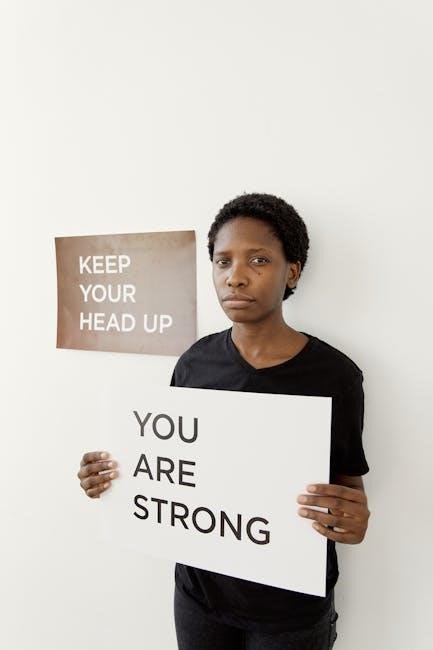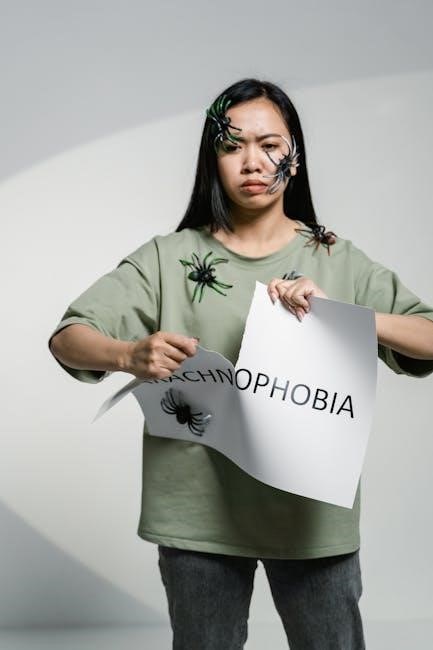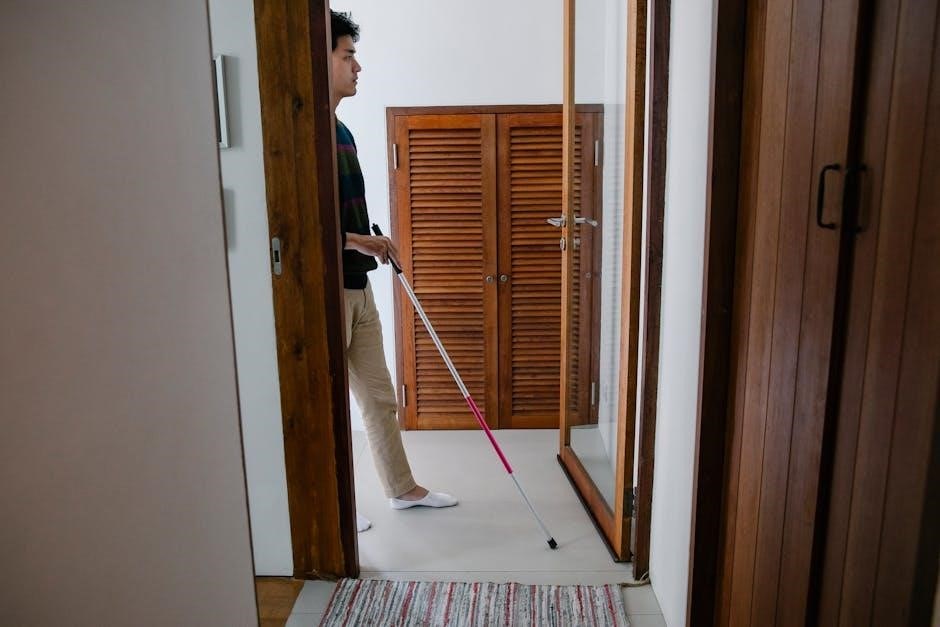Internalized homophobia refers to the involuntary absorption of societal prejudice, leading to self-loathing and shame among LGBTQ+ individuals. It stems from external discrimination and negative messaging, deeply affecting mental health and self-perception. Overcoming this requires self-awareness, acceptance, and support, enabling individuals to embrace their authentic selves and find liberation from internalized shame.
1.1 Definition and Understanding
Internalized homophobia is a psychological phenomenon where individuals unconsciously adopt societal prejudices against their own LGBTQ+ identity. It manifests as self-loathing, shame, and rejection of one’s true self due to internalized negative messages. This deeply ingrained bias often stems from cultural, familial, or religious environments that stigmatize queerness. Understanding this concept is crucial, as it shapes self-perception and behaviors, hindering self-acceptance and mental well-being. Recognizing its roots in external oppression is the first step toward healing and reclaiming authenticity.
1.2 The Impact on Mental Health
Internalized homophobia significantly affects mental health, often leading to low self-esteem, anxiety, and depression. The constant struggle with self-acceptance can result in emotional distress and self-destructive behaviors. Many individuals experience feelings of isolation and alienation, further exacerbating mental health challenges. The internal conflict between societal expectations and personal identity can hinder emotional well-being, making it essential to address these issues through self-reflection and supportive environments to foster healing and resilience.
1.3 The Importance of Addressing Internalized Homophobia
Addressing internalized homophobia is crucial for emotional well-being and self-acceptance. It allows individuals to break free from self-imposed shame and embrace their true identities. By confronting and challenging negative beliefs, one can develop resilience and improve mental health. Seeking support through therapy, community, and education fosters a journey of healing and empowerment, enabling individuals to live authentically and find peace with their sexuality.

Causes of Internalized Homophobia
Internalized homophobia arises from societal norms, personal trauma, and lack of representation, leading individuals to internalize negative beliefs about their identity, fostering self-shame and emotional conflict.
2.1 Sociocultural Factors
Sociocultural factors, such as discrimination, religious beliefs, and societal norms, significantly contribute to internalized homophobia. Growing up in environments where being LGBTQ+ is stigmatized or invisible can lead to self-shame. Media representation, or its lack, also plays a role, as limited positive portrayals reinforce negative stereotypes. These external pressures often result in individuals internalizing homophobic attitudes, viewing themselves through a lens of societal disapproval, and struggling to embrace their authentic identities. Addressing these factors is crucial for healing and self-acceptance.
2.2 Personal Experiences and Trauma
Personal experiences, such as bullying, rejection by family or friends, and traumatic events, can deeply embed internalized homophobia. These experiences often lead to feelings of inadequacy and self-loathing, as individuals internalize the hurtful messages directed at them. Trauma, particularly in formative years, can make it difficult to accept one’s identity, fostering a cycle of shame and self-doubt. Therapy and support systems play a crucial role in helping individuals process these experiences and work toward healing and self-acceptance.
2.3 Lack of Representation and Visibility
Lack of representation and visibility in media, culture, and society contributes to internalized homophobia. When individuals rarely see themselves reflected positively, it reinforces feelings of invisibility and worthlessness. This absence perpetuates negative stereotypes and self-doubt, making it harder to embrace one’s identity. Increased representation and diverse role models are essential for fostering acceptance and helping individuals recognize their value and legitimacy within society.
Recognizing the Signs of Internalized Homophobia
Internalized homophobia often manifests as self-loathing, shame, or fear of being “out.” It may lead to avoidance of LGBTQ+ communities or self-destructive behaviors, hindering self-acceptance and relationships.
3.1 Self-Loathing and Shame
Self-loathing and shame are core manifestations of internalized homophobia, often rooted in societal prejudice. Individuals may feel unworthy or disgusted with their identity, believing being LGBTQ+ is inherently wrong. This internalized negativity can lead to self-hatred, low self-esteem, and a deep-seated fear of acceptance. Recognizing these feelings is the first step toward healing, as it allows individuals to address and challenge the harmful beliefs they’ve internalized over time.
3.2 Fear of Being “Out”
Fear of being “out” is a common sign of internalized homophobia, often rooted in societal prejudice and personal trauma. Individuals may dread rejection, judgment, or harm if their true identity is revealed. This fear can lead to secrecy, isolation, and emotional distress. Coming out is seen as a positive developmental step, but internalized shame can make it feel daunting. Overcoming this fear requires a supportive environment and gradual self-acceptance, helping individuals embrace their authenticity without fear of repercussions.
3.3 Avoidance of LGBTQ+ Communities
Avoidance of LGBTQ+ communities is a sign of internalized homophobia, often driven by shame or fear of being judged. Individuals may feel unworthy of belonging or believe they don’t fit in. This isolation can worsen feelings of loneliness and self-hatred. Engaging with supportive communities can provide validation and acceptance, helping to counteract internalized negativity. Avoidance prevents access to resources and connections that are crucial for healing and self-acceptance, perpetuating the cycle of internalized homophobia and emotional distress.
3.4 Self-Destructive Behaviors
Self-destructive behaviors often manifest as a coping mechanism for internalized homophobia, stemming from deep-seated shame and self-loathing. These behaviors may include substance abuse, self-sabotage, or risky actions that harm one’s well-being. Such actions can perpetuate a cycle of guilt and self-hatred, worsening mental health. Addressing these behaviors requires acknowledging their root cause—internalized homophobia—and seeking support to develop healthier coping strategies. Breaking this cycle is crucial for healing and fostering self-compassion and acceptance.

The Psychological Impact
Internalized homophobia can lead to severe mental health issues, including anxiety, depression, and low self-esteem. It fosters self-loathing and emotional turmoil, hindering personal growth and well-being.
4.1 Low Self-Esteem and Confidence
Internalized homophobia often manifests as deep-seated self-doubt, leading to low self-esteem and a lack of confidence. Individuals may struggle with negative self-perceptions, feeling inadequate or unworthy due to societal prejudice. This emotional burden can hinder personal growth, making it difficult to assert oneself or form healthy relationships. The internalized shame can create a cycle of self-criticism, further eroding confidence and self-worth, emphasizing the need for self-compassion and support to rebuild a positive self-image.
4.2 Anxiety and Depression
Internalized homophobia often leads to chronic anxiety and depression, as individuals grapple with societal prejudice and self-loathing. The emotional burden of hiding one’s true identity can exacerbate mental health struggles, making it difficult to cope with daily life. Addressing these issues requires a supportive environment and self-compassion to heal and embrace authenticity.
4.3 Difficulty in Forming Healthy Relationships
Internalized homophobia can hinder the formation of healthy relationships by fostering fear of rejection and intimacy. Shame and self-doubt may lead to unhealthy patterns, such as people-pleasing or emotional detachment. Building trust and communication becomes challenging, as individuals may struggle to express their true selves. Healing involves self-acceptance and seeking supportive partners who validate their identity, allowing for authentic and fulfilling connections to flourish.
4.4 Substance Abuse and Coping Mechanisms
Internalized homophobia often leads to substance abuse as individuals seek escape from emotional pain and self-loathing. Drugs or alcohol may temporarily alleviate feelings of shame but worsen mental health struggles. This coping mechanism avoids addressing the root causes, perpetuating a cycle of self-destructive behavior. Recognizing this pattern is crucial for healing, as it allows individuals to seek healthier ways to manage their emotions and work toward self-acceptance and recovery.

Understanding the Journey to Overcoming
Overcoming internalized homophobia involves a gradual process of self-awareness, acceptance, and healing. It requires confronting deeply ingrained beliefs and embracing one’s true identity with compassion and support.

5.1 The Role of Self-Awareness
Self-awareness is the cornerstone of overcoming internalized homophobia. It involves recognizing and understanding the deeply ingrained beliefs and emotions that contribute to self-loathing. By acknowledging these feelings, individuals can begin to challenge harmful narratives and reframe their identity positively. Self-awareness fosters introspection, allowing people to identify the sources of their internalized shame and address them constructively. This process empowers individuals to develop a more compassionate and authentic relationship with themselves, laying the foundation for healing and growth.
5.2 The Importance of Acceptance
Acceptance is a pivotal step in overcoming internalized homophobia, allowing individuals to embrace their true selves without judgment. It involves acknowledging their identity as valid and worthwhile, despite societal or internalized negativity. Acceptance fosters self-compassion and reduces the grip of shame, enabling personal growth and healing. By accepting themselves, individuals can break free from self-hatred and cultivate a positive, affirming relationship with their identity, which is essential for mental well-being and authenticity.
5.3 The Process of Redefining Identity
Redefining identity involves reclaiming and reinterpreting one’s sense of self, moving beyond the constraints of internalized homophobia. This process requires introspection, self-compassion, and the integration of positive LGBTQ+ narratives. By challenging negative beliefs and embracing authenticity, individuals can construct a more affirming and empowered identity. This journey fosters resilience, allowing individuals to align their self-perception with their true nature, leading to greater confidence and a more fulfilling life free from the burdens of internalized shame.
Practical Steps to Overcome Internalized Homophobia
Overcoming internalized homophobia involves challenging negative beliefs, building self-compassion, and engaging in self-reflection. These steps empower individuals to embrace their authenticity and foster a healthier self-image.
6.1 Challenging Negative Beliefs
Challenging negative beliefs involves identifying and questioning harmful, internalized messages about oneself. Techniques like cognitive restructuring and journaling can help replace self-critical thoughts with affirming ones. Exposure to positive representations of LGBTQ+ individuals and education about queer history can also counteract internalized prejudice. This process fosters self-acceptance and reduces the grip of shame, enabling individuals to embrace their authentic selves more fully.

6.2 Building Self-Compassion
Building self-compassion is crucial for healing from internalized homophobia. It involves treating oneself with kindness, understanding, and patience, rather than judgment. Practices like mindfulness, self-care rituals, and affirmations can help cultivate a nurturing relationship with oneself. Recognizing that internalized shame is a result of external prejudice, not personal failure, fosters empathy and reduces self-criticism. By embracing self-compassion, individuals can gradually replace self-hatred with self-love and acceptance, paving the way for emotional healing and growth.
6.3 Engaging in Self-Reflection
Engaging in self-reflection is a powerful tool for addressing internalized homophobia. It involves examining personal beliefs, feelings, and experiences to identify and challenge harmful, ingrained attitudes. Journaling, meditation, or therapy can facilitate this process, helping individuals confront shame and self-doubt. By exploring the roots of their internalized beliefs, people can gain clarity and begin to reframe their self-perception. Self-reflection fosters accountability and growth, enabling individuals to move toward self-acceptance and emotional freedom with patience and self-kindness.

The Role of Support Systems
Support systems, including therapy, support groups, and understanding communities, play a vital role in helping individuals overcome internalized homophobia by providing validation, guidance, and a sense of belonging.
7.1 The Importance of Therapy
Therapy is a crucial tool for addressing internalized homophobia, offering a safe space to explore and challenge deeply ingrained negative beliefs. Trained therapists can help individuals identify and reframe harmful self-perceptions, fostering self-compassion and acceptance. Through guided reflection, therapy provides coping strategies to manage shame and self-hatred, while also supporting the development of a positive identity. A therapist can also connect individuals to additional resources, such as support groups, further aiding the healing journey.
7.2 Joining Support Groups
Joining support groups provides a sense of community and understanding, helping individuals combat feelings of isolation. These groups offer a platform to share experiences and receive validation, fostering connection and mutual support. They also provide practical advice and encouragement, empowering individuals to challenge internalized homophobia. Being part of a supportive community can enhance self-esteem and resilience, making the journey toward self-acceptance more manageable and less solitary.
7.3 Building a Supportive Community
Building a supportive community is crucial for overcoming internalized homophobia. Surrounding oneself with positive influences and like-minded individuals fosters acceptance and understanding. This environment encourages open dialogue, reducing feelings of isolation and shame. A supportive community provides emotional validation, helping individuals reframe negative self-perceptions. It also offers practical resources and encouragement, empowering personal growth and self-acceptance. By creating safe spaces, individuals can thrive and embrace their authentic selves without fear of judgment.

Embracing Authenticity
Embracing authenticity involves accepting your true self, fostering self-love, and surrounding yourself with supportive communities that encourage openness and acceptance, helping to overcome internalized shame and self-hatred.
8.1 Accepting Your True Self
Accepting your true self is the foundation of overcoming internalized homophobia. It involves acknowledging and embracing your identity without shame, fostering self-compassion, and recognizing your inherent worth. Surrounding yourself with supportive communities and positive influences can help counteract negative internalized beliefs. This journey requires patience and self-reflection, as it often involves unlearning societal prejudices and redefining self-perception. By accepting your authentic self, you pave the way for healing and liberation from the burdens of internalized shame.
8.2 Finding Role Models and Mentors
Finding role models and mentors is crucial in overcoming internalized homophobia. They inspire self-acceptance and provide guidance, helping you navigate feelings of shame. Role models, like LGBTQ+ advocates or public figures, demonstrate resilience and pride, offering a blueprint for embracing your identity. Mentors can share their experiences, offering wisdom and encouragement. Surrounding yourself with positive influences and seeking mentorship fosters growth and confidence, aiding in the journey toward self-acceptance and liberation from internalized shame.
8.3 Celebrating LGBTQ+ Culture
Celebrating LGBTQ+ culture is a powerful way to counteract internalized homophobia. Engaging with art, history, and community events fosters pride and connection. Pride parades, LGBTQ+ films, and literature highlight diverse experiences, promoting self-acceptance. Embracing cultural heritage helps individuals reclaim their identity, moving from shame to empowerment. Surrounding yourself with vibrant, affirming expressions of LGBTQ+ life nurtures resilience and joy, transforming internalized negativity into pride and self-love.

Creating a Supportive Environment
Creating a supportive environment involves surrounding yourself with positive influences, setting boundaries with toxic individuals, and fostering safe spaces for self-expression and healing. This promotes emotional well-being and acceptance, helping to counteract internalized homophobia by encouraging authenticity and resilience in a nurturing setting.
9.1 Surrounding Yourself with Positive Influences
Surrounding yourself with positive influences is crucial for overcoming internalized homophobia. Being around supportive, affirming individuals helps counteract negative societal messages and fosters self-acceptance. Engaging with role models, such as LGBTQ+ advocates or influencers like Zachary Willmore, can inspire confidence and pride. Additionally, joining communities like TrevorSpace provides a safe space for connection and growth, helping you build resilience and embrace your authentic self. Positive influences nurture emotional well-being and empower you to challenge internalized shame.
9.2 Setting Boundaries with Toxic People
Setting boundaries with toxic individuals is essential for overcoming internalized homophobia. People who reinforce negative beliefs or reject your identity can exacerbate feelings of shame. Distancing yourself from such individuals protects your mental health and fosters self-acceptance. By prioritizing relationships with supportive, affirming people, you create space for healing and growth. Boundaries are not about cutting ties but about safeguarding your well-being and embracing a life free from toxic influences that perpetuate self-hatred and internalized shame.
9.3 Creating Safe Spaces
Creating safe spaces is crucial for healing from internalized homophobia. These environments, whether physical or emotional, allow individuals to express themselves authentically without fear of judgment. Safe spaces foster connection, acceptance, and understanding, helping to counteract the harmful effects of societal prejudice. By surrounding yourself with supportive communities and like-minded individuals, you can gradually dismantle internalized shame and build a foundation of self-acceptance and empowerment, essential for overcoming self-hatred and embracing your true identity.
The Role of Education and Advocacy
Education and advocacy are powerful tools in combating internalized homophobia. Learning about LGBTQ+ history and engaging in activism can help challenge harmful beliefs and promote acceptance, fostering a more inclusive and supportive environment for all individuals to thrive authentically.
10.1 Educating Yourself About LGBTQ+ History
Educating yourself about LGBTQ+ history is crucial in overcoming internalized homophobia. Understanding the struggles and triumphs of the community helps challenge harmful stereotypes and fosters pride. Learning about key events, such as the Stonewall Riots, and figures like Marsha P. Johnson, provides context and inspiration. This knowledge reconnects individuals to their heritage, reducing feelings of isolation and shame. It also highlights resilience and progress, empowering individuals to embrace their identity with confidence and authenticity.
10.2 Engaging in Activism
Engaging in activism is a powerful way to combat internalized homophobia. By advocating for LGBTQ+ rights, individuals can challenge societal norms and reclaim their identity with pride. Activism fosters a sense of purpose and community, helping to dismantle internalized shame. Whether through volunteering, protesting, or educating others, activism empowers individuals to fight for their rights and promote acceptance. It also connects people to a larger movement, reducing feelings of isolation and fostering solidarity. This collective effort aids in personal healing and societal change.
10.3 Promoting Awareness and Understanding
Promoting awareness and understanding is crucial in addressing internalized homophobia. Education about LGBTQ+ history and experiences helps dismantle stereotypes and misconceptions. By sharing personal stories and fostering open conversations, individuals can reduce stigma and encourage empathy. Awareness campaigns highlight the impact of internalized homophobia, encouraging others to reflect on their beliefs. This collective effort creates a more inclusive environment, empowering individuals to embrace their identities and fostering a culture of acceptance and understanding.

The Journey of Self-Discovery
Self-discovery involves exploring your identity, embracing uniqueness, and finding purpose. It’s a personal journey of growth, where individuals confront internalized homophobia and develop self-acceptance, fostering authenticity and empowerment.
11.1 Exploring Your Identity
Exploring your identity involves understanding your sexual orientation, gender, and personal values. It’s a process of self-reflection, where individuals confront societal norms and internalized messages. This journey helps individuals move beyond shame, embracing their authentic selves. By examining personal beliefs and experiences, one can develop a clearer sense of self, fostering self-acceptance and empowerment. This step is crucial in overcoming internalized homophobia, as it lays the foundation for healing and living authentically.
11.2 Embracing Your Unique Experience
Embracing your unique experience involves acknowledging and valuing your personal journey, including struggles and triumphs; Recognizing the validity of your feelings and experiences helps you move past shame and self-doubt. By accepting your individuality, you foster self-compassion and empowerment. This process allows you to redefine your identity on your own terms, free from societal expectations. Surrounding yourself with supportive communities and resources, like therapy, can further enhance this journey of self-acceptance and growth.
11.3 Finding Purpose and Meaning
Finding purpose and meaning is a transformative step in overcoming internalized homophobia. It involves aligning your values and passions with your authentic self, fostering a sense of direction and fulfillment. Engaging in activities that bring joy and contribute to others can help rebuild self-worth. This journey of self-discovery allows you to redefine your identity and create a life that reflects your true self, moving beyond shame and embracing a future filled with purpose and meaning.
Overcoming internalized homophobia is a lifelong journey of healing, self-care, and embracing authenticity. It requires courage, support, and compassion, leading to a brighter, more fulfilling future.
12.1 The Ongoing Process of Healing
Healing from internalized homophobia is a continuous journey requiring patience and self-compassion. It involves challenging negative beliefs, embracing your true identity, and seeking support. Therapy, support groups, and exposure to positive influences can aid this process. Progress, not perfection, is key. Celebrate small victories and remain committed to your growth. Each step forward is a testament to resilience and courage, fostering a brighter, more authentic future.
12.2 The Importance of Self-Care
Self-care is essential for healing from internalized homophobia, as it fosters emotional resilience and self-compassion. Engaging in activities like therapy, mindfulness, and creative expression can help redefine identity and build confidence. Prioritizing mental health through self-care practices allows individuals to address shame and self-hatred constructively. By nurturing their well-being, they can embrace authenticity and develop a positive self-image, which is crucial for long-term healing and personal growth.
12.3 Embracing a Brighter Future
Overcoming internalized homophobia opens the door to a brighter future, where self-acceptance and authenticity prevail. By healing from shame and self-hatred, individuals can embrace their true selves, fostering personal growth and empowerment. Surrounding oneself with supportive communities and practicing self-compassion are key to this journey. Embracing a brighter future means living a life free from internalized prejudice, where one’s identity is celebrated, and their contributions to the world are meaningful and fulfilling.
